Transplanting peonies to another place in the fall
Lush and delicate peonies are a real find for Russian gardeners. The flowers are unpretentious, fragrant, and grow well in any type of soil. In order for the flower garden to live long and grow, it is transplanted to a new location once every 5 years. The procedure requires special preparation: it is important to study the division of the root and step-by-step instructions. Let's look at how to transplant peonies to a new place in the fall and what you will need for this.
Why replant peonies?
The purpose of replanting is to extend the life of plants and make them bloom magnificently and not get sick. Replanting flowers for rejuvenation; if this is not done, the peonies weaken every year until they die completely. Their roots rot and do not receive enough heat and light.
It is recommended to replant the plant every 5 years. This is the optimal time for all types and varieties of peonies. However, tree-like flowers are transferred to a new place once every 10 years, but subject to all care rules.
When is it better to replant peonies: in autumn or spring?
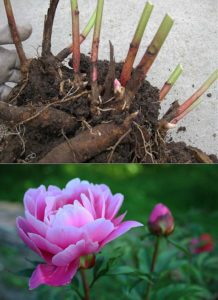
The procedure is carried out mainly in the fall: gardeners believe that this is the most favorable time. Peonies quickly take root in a new place and bloom profusely the following year.
If you don’t have time to replant the plants in the fall, do it in the spring. The main thing is to wait until all the snow melts and the ground warms up to a temperature of at least +10°C.
The disadvantages of spring planting are that the bushes take a long time to take root and become sick. The suction roots of peonies break off, which negatively affects the development of buds and the plant as a whole.
In the fall, these roots grow, allowing the plant to quickly take root and receive nutrients from the ground. This peony is less likely to get sick and is susceptible to attacks by insect pests, and is characterized by strong immunity and frost resistance.
Optimal timing for autumn transplantation
When choosing a day, some gardeners pay attention to the climatic conditions of the region, others - to the recommendations of the lunar calendar. Some people take into account several factors at once.
By region
In the middle zone or Moscow region, the procedure begins at the end of August or the first half of September. In this case, the rule applies: the sooner, the better.
Attention! A suitable day for replanting flowers is calm, warm, and without precipitation. The optimal air temperature is about +15°C. It is recommended to check the weather forecast in advance and select a date.
The main thing is to have time to replant the flower garden before the first frost. In the Urals and Siberia this is the second ten days of August. In the southern regions (for example, in the Rostov region), the procedure is postponed until the end of September or the beginning of October.
According to the lunar calendar
The lunar calendar helps summer residents choose the most suitable days for the procedure.
In 2020, these are all days of September, except 1, 2, 3, 10, 17, 21, 22, 23, and all days of October, except 1–3, 15–17, 30, 31.
Moon calendar for 2021 offers the following favorable days for autumn transplantation of peonies: September 4–6, 11–13, 24–28 and October 4–7, 11–13, 25–27.
How to replant correctly
To understand how to replant peonies in the fall, many factors are studied: choice of location landings, suitable soil, adherence to technology.
Peony cannot be called a capricious flower, but it requires careful handling, because moving to a new place is stressful for any plant.
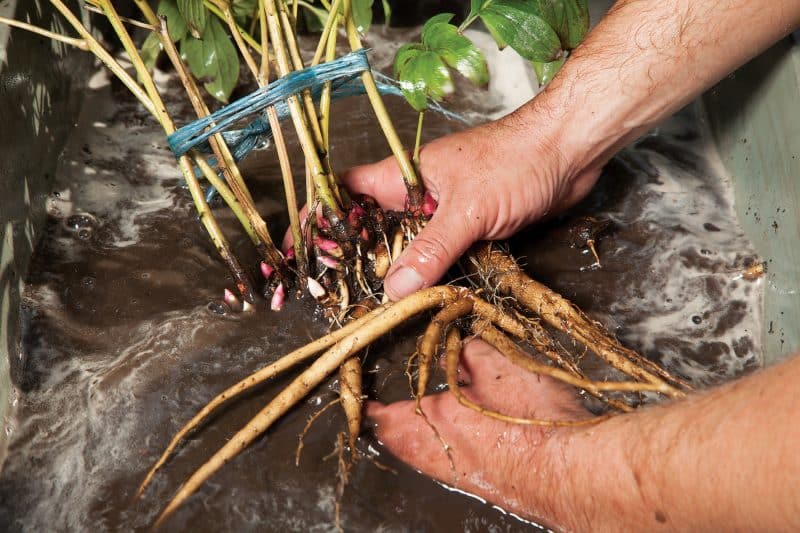
Selecting a location
Peony grows well in a sunny area or in light partial shade. The place should be spacious and clean, free of debris and plant debris. There should be no spreading trees or shrubs nearby: they obscure the flower garden.
The flower is not planted in the shade: due to the lack of sunlight, the buds become smaller and the roots develop slowly.
A suitable location is an area protected from the winds and located on a hilly area on the southeast side. Wet lands that are located next to groundwater or near open bodies of water (rivers, lakes and especially swamps) are not suitable.
It is better to transplant peonies to elevated beds to be sure that groundwater will not reach them. The soil acidity is preferably neutral, the composition is loamy or sandy loam.
Priming
The soil for peonies is prepared independently 2–4 weeks before transplantation. A planting hole 60 cm deep and 70 cm wide is prepared on the site (dimensions vary depending on the size of the flowers), the bottom is thoroughly loosened and cleaned of plant debris. Afterwards the soil is prepared: humus, peat and top layer of soil are mixed in equal parts.
If desired, add some leaf or turf soil - thanks to it, the soil mixture will become even more nutritious and fertile.
Attention! If the soil is heavy, a drainage layer is laid on the bottom: expanded clay, crushed stone, sand, marble chips, gravel. It is recommended to ensure that this layer is uniform and without voids.
200 g of bone meal and 100 g of superphosphate are added to the pit. This fertilizing normalizes the acidity of the soil and saturates it with microelements, which are required for the flowers to adapt to the new growing location. The top layer of the pit is made from clean and crumbly garden soil.
Transplant technology
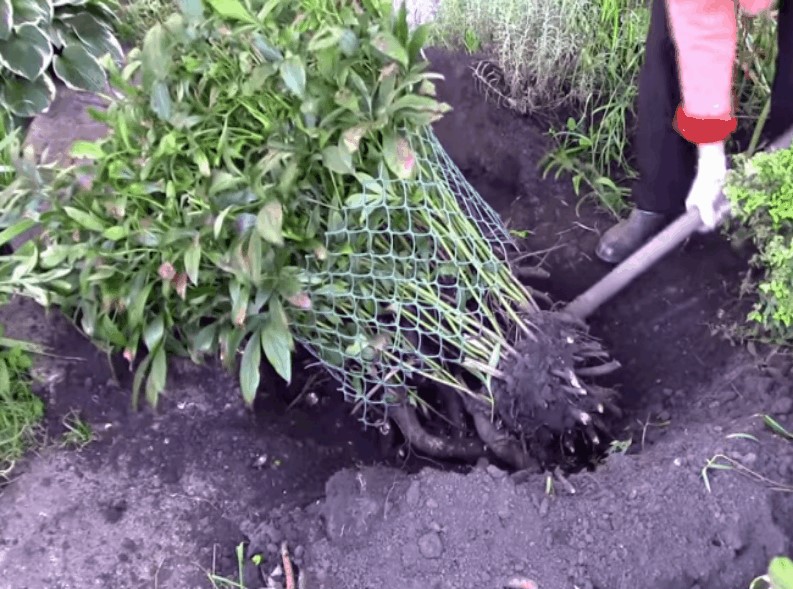
Before replanting peonies to a new location, it is important to water the soil generously: 1 bush requires about 10–15 liters of water. Further:
- Carefully dig up the bush along the trunk circle, retreating 25 cm.
- Shake the bushes and remove them from the ground along with the roots. In this case, you need to be prepared for the fact that some of the roots will break off.
- Rinse the rhizome under a weak stream of water from a hose.
- Leave the plant in the shade for 3 hours so that the roots dry out and become elastic.
- Divide the roots by hand or with a sharp knife into 2-3 parts so that 3-5 buds remain on each, and the length of the roots is no more than 20 cm.
- Place the cuttings in a new place and sprinkle loose soil on top.
- Compact, water generously and sprinkle with mulch: sawdust, straw, sand, hay, dry leaves.
Experienced gardeners recommend paying special attention to the division stage. It is important to carefully examine the cuttings from all sides and trim off parts with stains or traces of rot.
The sections are coated with brilliant green and placed in a solution of potassium permanganate for disinfection. Afterwards, the plants are sent to the Kornevin growth stimulator. It strengthens the culture’s immunity and guarantees rapid establishment in a new place.
Aftercare
Proper and timely care after the procedure is the key to ensuring that peonies quickly adapt to a new place and growing conditions.
First of all, gardeners pay attention to watering, fertilizers and pruning. It is important to regularly loosen the plant and properly prepare it for winter.
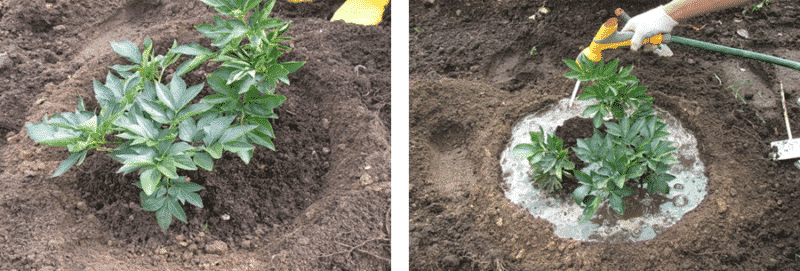
Watering
If in summer peonies are watered once every 3-4 days, then in the fall, after replanting, the amount of moisture is reduced by half. Moisten the flower garden for the first time immediately after the procedure, and for the second time a week later.
Attention! Some summer residents make the mistake of stopping watering the plant immediately after replanting, guided by the fact that the peony will no longer bloom this year. This is wrong: moisture is required not only for flowering, but also for nutrition and maintaining immunity.
Use settled water at room temperature and pour it into the tree trunk circle. This is done early in the morning, after loosening the soil. Stop watering 3 weeks before frost.
Feeding
Fertilizing is required only if superphosphate, peat, ash and other organic fertilizers were not added to the planting hole during transplantation. In such a situation, a week after the procedure, add 40 g of potassium sulfate or 50 g of superphosphate per 1 m².
If you have herbs on hand (nettle, tansy, chamomile, calendula, sage), an infusion is prepared from them: 300 g of plants are soaked in 5 liters of water, covered with a lid and left for 4 days in a dark place. Peonies are watered a month before expected frost.
In October, rotted horse manure is scattered on peony beds. It decomposes throughout winter and spring and nourishes the earth. With such fertilizing in the spring, you will not have to fertilize the soil with nitrogen: all the necessary substances are already in the soil. Cow or pelleted poultry manure is used instead of horse manure.
Loosening, hilling
The soil is loosened to prevent the appearance of weeds, many of which become active in the fall. Peonies are loosened to a depth of 10 cm, no more. Otherwise, it is easy to damage the root collar of the plant. Thanks to the procedure, the plant breathes and grows well. The procedure is carried out once a week, more often if it rains.
Hilling up is one of the ways to cover for the winter. It protects peonies not only from weeds and pests, but also from frost.A mound 20 cm high is poured around the bush. To make hilling more beneficial, use not ordinary garden soil, but peat or humus. Carry out the procedure before the soil freezes. Suitable temperature is about +5°C.
Trimming
Peonies are not pruned immediately after flowering, but 2 weeks before frost. As soon as the leaves change color and begin to lean down, they are carefully cut out with garden shears or removed by hand. For herbaceous peonies, the entire above-ground part is removed.
Attention! After pruning, peonies are treated to protect them from diseases and insect pests. Use a solution of copper sulfate or Bordeaux mixture. The procedure protects plants from aphids, bronzes, thrips, gray rot, and rust.
The stems are cut as close to the ground as possible, leaving only 2-3 cm. All actions are performed carefully so as not to tear off the stems along with the buds.
Wintering
After pruning, fertilizing and weeding, the bushes are prepared for wintering. Peonies are heat-loving, so even the most frost-resistant varieties are covered for the winter. Young peonies aged 1-2 years are especially carefully insulated.
Fallen leaves are used as covering material: they are collected in bags in advance, dried in a warm place and only then placed in a flowerbed. Oak leaves do an excellent job: they do not rot and protect well from the cold.
It is recommended to mulch the plants for the winter. Sawdust or bark is used as mulch. They nourish the soil, protect from rodents and insects, and cold weather. The mulch layer should be thick - at least 20 cm.
In cold regions of the country, young plants are covered with a wooden box. As soon as the snow falls, it is carefully compacted to further protect the plants.
Additional tips, lifehacks
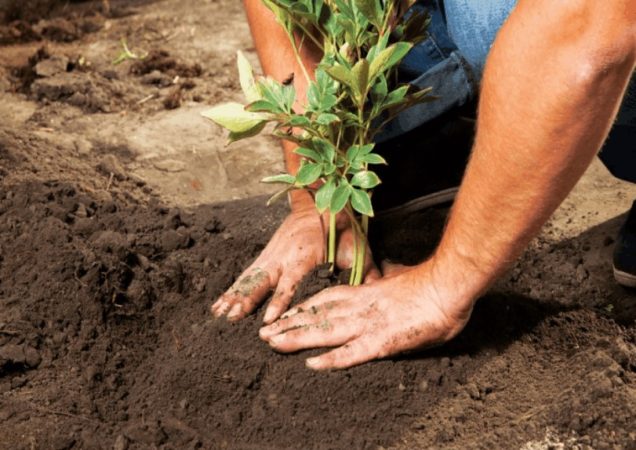
To ensure that peonies enjoy lush and long flowering, experienced gardeners share secrets and life hacks for growing:
- The roots of the peony are very delicate - swollen, tuberous. They go 1 m underground. Therefore, it is better to dig them out with a garden fork rather than a shovel.
- The bulk of the roots of peonies are located along the perimeter of the crown; they are not located under the stems. This is important to remember when distributing fertilizers.
- Peonies respond well to liquid mineral fertilizers: Agricola or Gumi-Omi. It is important that the granules are well dissolved in water before using fertilizer.
- In the fall, do not apply nitrogen-containing products: they will awaken dormant buds, and the peony will not bloom the next year.
- When replanting, the soil level should be 3-4 cm below the root bud, otherwise the roots will freeze in winter.
To determine when to replant peonies in the fall, look at weather conditions and the forecast for the next couple of weeks.
Conclusion
Transplanting peonies to another place in the fall is a simple procedure, but it has some peculiarities. To begin, flower growers choose a new flowerbed and prepare a planting hole. Next, they dig up the bush, divide the roots, wash it with water and leave it in the shade for several hours. The cuttings are placed in a hole, covered with earth, watered and mulched.
In order for peonies to quickly take root in a new area, it is recommended to trim them, feed them and cover them with peat.